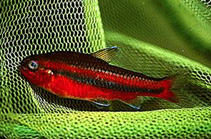| Family: |
Distichodontidae (Distichodus) |
| Max. size: |
4.1 cm SL (male/unsexed) |
| Environment: |
pelagic; freshwater; dH range: 12 |
| Distribution: |
Africa: present in the middle and upper Congo River basin (Ref. 81638, 94734, 106245, 106290) and the Nile (Ref. 28714, 94734) basin. Present in Cameroon, Gabon, Republic of Congo, Cabinda (Ref. 81638), Democratic Republic of the Congo and South Sudan (Ref. 94734). |
| Diagnosis: |
Dorsal spines (total): 0-0; Dorsal soft rays (total): 10-14; Anal spines: 0-0; Anal soft rays: 12-15. Diagnosis: laterosensory canal on lateral surface of head limited to arch of pores around ventral and posterior margins of orbit and associated with preopercle; 6th infraorbital (dermosphenotic) present, with laterosensory canal segment; infraorbital present at posterior margin of orbit; maxilla with 4 or fewer teeth, reaching past vertical through anterior margin of orbit; scaly process present at base of pelvic fin; dark pigmentation along lateral surface of body two scales wide or less; dark band on lateral surface of body passing through lower portion of caudal peduncle; base of caudal fin unpigmented or with rounded spot that falls distinctly short of dorsal and ventral margins of caudal peduncle (Ref. 81638).
Description: body moderately robust, more so anteriorly, depth 0.30-0.40x SL; head profile moderately acute anteriorly; premaxilla and dentary with 2 rows of teeth; teeth of outer row bicuspid, teeth of inner row conical; premaxilla with 10 teeth in outer row, maxilla with 2 teeth on anterodorsal margin, dentary with 15-16 teeth in outer row; laterosensory canal system of head not elaborated; body scales ctenoid and of moderate size; lateral line incomplete with pores on anterior 3-8 scales; 12 scales between dorsal fin origin and mid-ventral line (excluding median scales); D: II-IV,8-10; A: II-III,10-12 (Ref. 81638).
Coloration: preserved specimens dark tan; dorsal portion of head darker, with scattered dark pigmentation on lateral surface; post-orbital region with variably developed dark pigmentation sometimes in form of horizontal band continuous posteriorly with band on body; scales of dorsal and dorsolateral surfaces of body margined by dark pigmentation that forms reticulate pattern; pattern less obvious in specimens with darker overall pigmentation; distinct dark, slightly ventrally decurved band extends from immediately behind margin of opercle to base of lower portion of lower lobe of caudal fin; region of body dorsal of short lateral line scale series dusky, with darker area extending posteriorly as irregular dark band of variable length; region dorsal to band relatively do distinctly dark; caudal fin with basal portion of central rays of lower lobe with dark spot contiguous posteriorly with body stripe; remainder of caudal fin and all other fins variably dusky, typically more so in larger specimens (Ref. 81638). |
| Biology: |
Maximum TL was recorded at 5.3 cm (Ref. 7094). Occurs in fringing vegetation; omnivorous browser, consumes plant fragments, algae, protozoans, rotifers, small crustaceans and insects (Ref. 28714). |
| IUCN Red List Status: |
Least Concern (LC); Date assessed: 16 February 2009 Ref. (130435)
|
| Threat to humans: |
harmless |
Source and more info: www.fishbase.org. For personal, classroom, and other internal use only. Not for publication.
